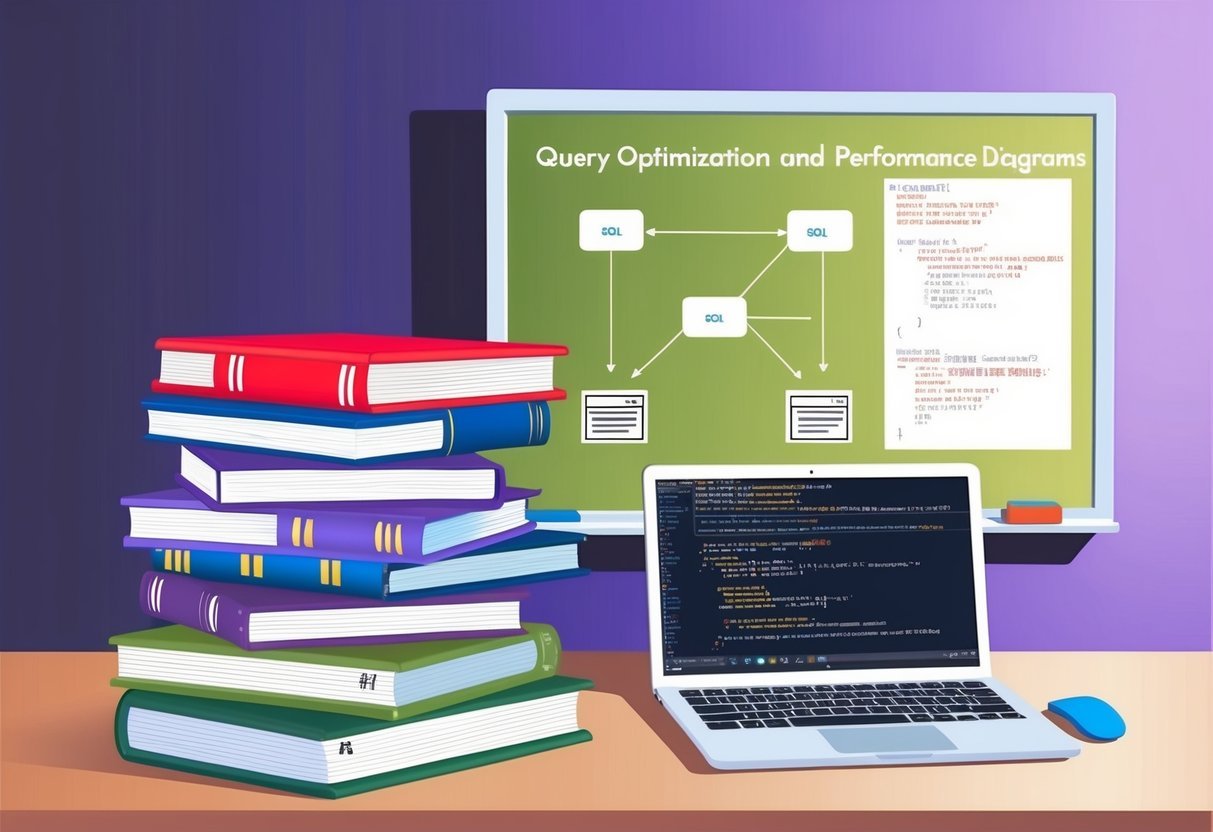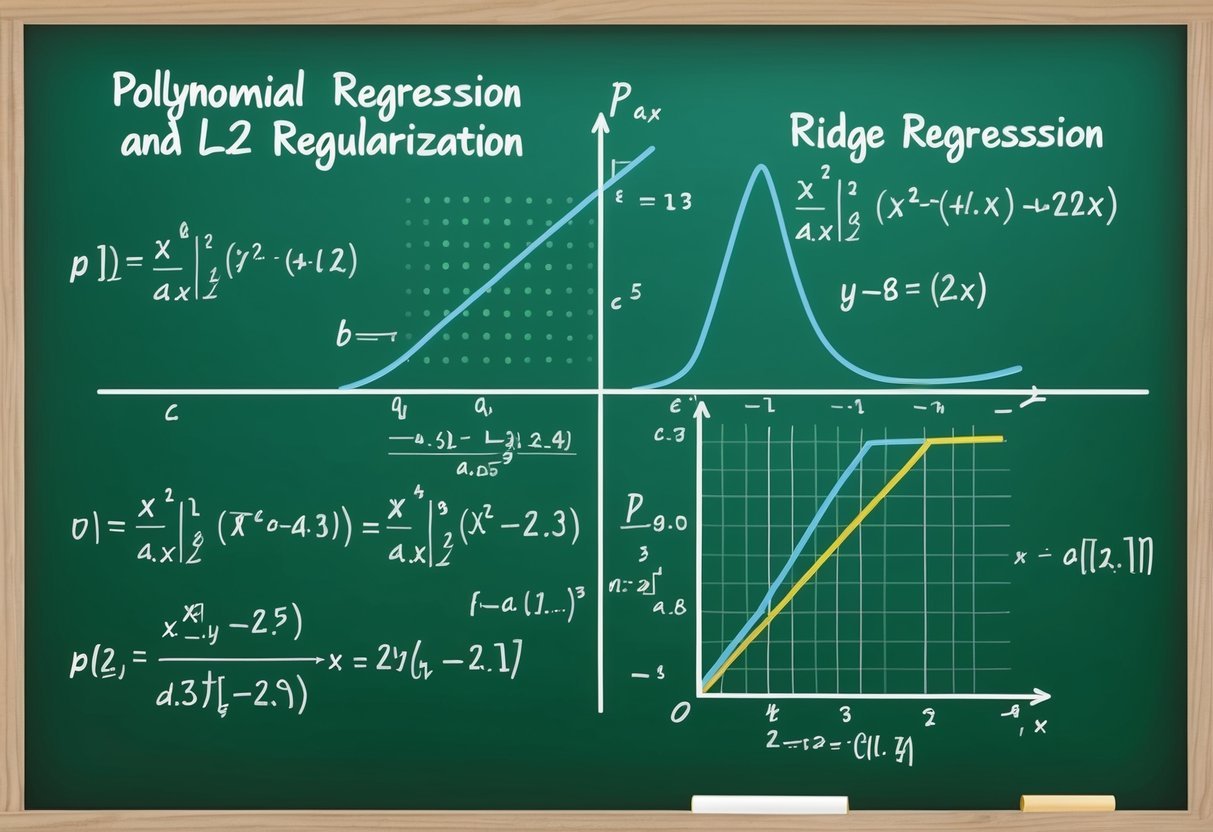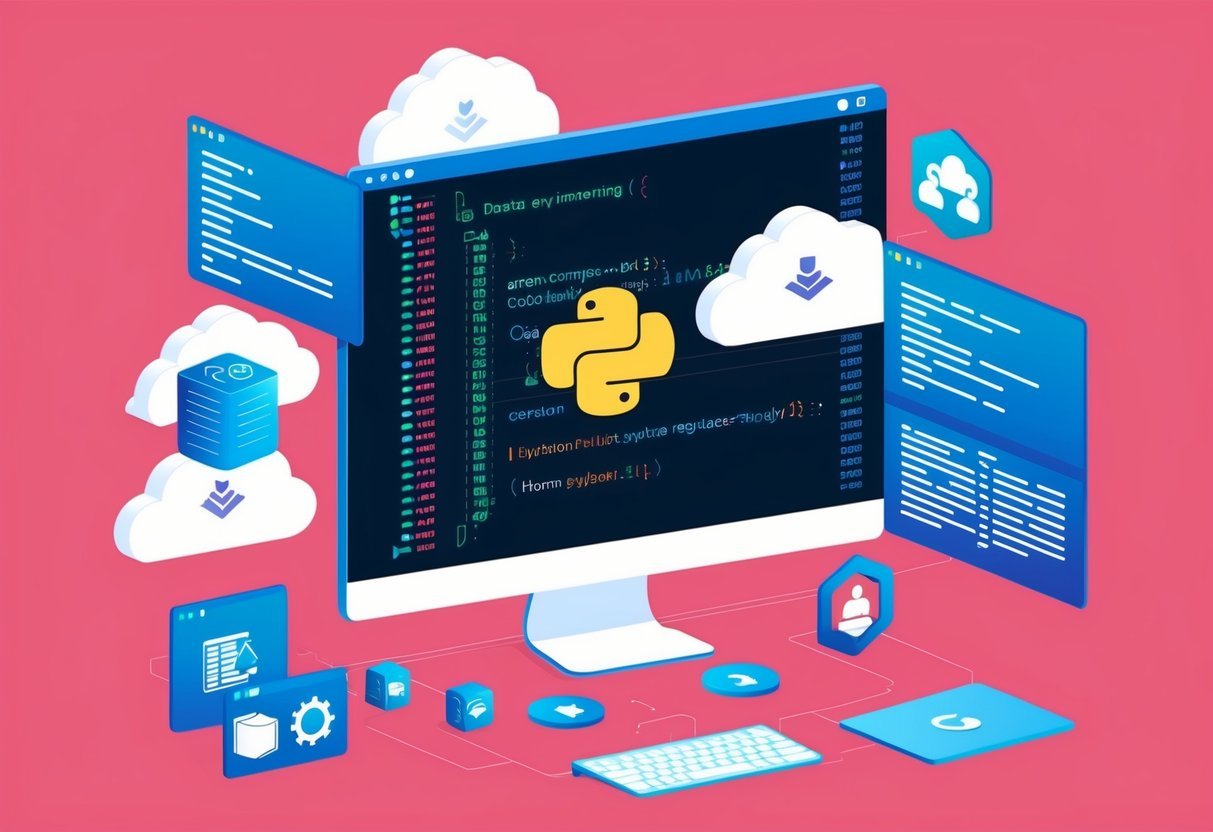Intermediate SQL Essentials
For an intermediate SQL developer, grasping advanced query techniques, joins, subqueries, and Common Table Expressions (CTEs) is crucial. These skills enhance the ability to handle complex data manipulation and retrieval tasks effectively.
Advanced Query Techniques
Intermediate SQL developers should focus on optimizing and refining their SQL queries. This includes understanding how to use indexing to improve query performance.
They should also learn about query execution plans to identify potential bottlenecks.
Employing functions like GROUP BY and HAVING can help in summarizing data. Such skills are vital for creating reports and analyzing datasets more efficiently.
Using CASE statements effectively allows for conditional data manipulation within queries.
Understanding Joins
Joins are essential for combining data from two or more tables. It’s important to master different types:
- Inner Joins: Retrieve records that have matching values in both tables.
- Left Joins: Return all records from the left table and matched records from the right table.
- Right Joins: Opposite of left joins.
- Full Joins: Capture all records when there is a match in either table.
Using these allows developers to build complex SQL queries that pull together diverse datasets, which is a frequent requirement in larger databases.
Mastering Subqueries and CTEs
Subqueries, also known as nested queries, allow a secondary query to be nested within a primary query. They help in breaking down complex SQL queries into manageable parts.
Common Table Expressions (CTEs), on the other hand, make queries more readable and maintainable.
CTEs are especially useful for recursive queries. They enable the creation of more modular code, which can be reused or iterated upon.
Becoming adept with subqueries and CTEs helps in managing hierarchical data and performing recursive operations, thus expanding the potential of what can be achieved through SQL.
Database Design and Manipulation
For an intermediate SQL developer, understanding database design and manipulation is crucial. The focus includes working effectively with multiple tables, utilizing Data Definition Language (DDL) for structuring databases, and applying Data Manipulation Language (DML) to change data efficiently.
Working with Multiple Tables
In relational databases, using multiple tables enhances data organization. Joining tables is a key skill.
SQL offers commands like JOIN, UNION, and INTERSECT to work with data spread over various tables. These commands help combine data based on shared fields.
For example, using INNER JOIN links two tables by their common columns, ensuring integrity.
Cross-referencing tables prevents data duplication and improves accuracy. Techniques such as normalization help maintain structured data, reducing redundancy.
Intermediates should practice writing queries that pull meaningful insights from complex table structures.
Data Definition Language (DDL)
DDL involves commands that define database structures. These include CREATE, ALTER, DROP, and TRUNCATE. Each plays a crucial role in building or modifying the database architecture.
For example, the CREATE TABLE command sets up a new table, specifying columns and data types. Alterations in table structures are managed with ALTER TABLE.
Removing entire tables or individual fields is done with DROP.
DDL ensures that relational databases remain well-organized and flexible as requirements change, so understanding these commands deeply is essential for any intermediate developer.
Data Manipulation Language (DML)
DML is all about interacting with existing data. Commands such as SELECT, INSERT, UPDATE, and DELETE are integral for handling data efficiently.
The SELECT statement retrieves specific data, while INSERT adds new records. When data needs adjustments, UPDATE modifies existing entries. To remove records, developers use DELETE.
Mastering DML allows developers to efficiently manage large datasets, ensuring the data remains relevant and consistent across database systems.
Effective use of DML leads to increased performance and reliability in database applications.
SQL Server Proficiency

Gaining proficiency in SQL Server involves mastering its features and understanding how to optimize performance using execution plans. Intermediate SQL developers should focus on key aspects like database structures and management systems to enhance their skills.
Utilizing Microsoft SQL Server Features
SQL Server offers a variety of features to improve data management and efficiency. Intermediate developers should be comfortable with various database structures, such as tables, views, and indexes.
Understanding how to use Stored Procedures and Triggers is crucial for automating tasks and improving performance.
Another essential aspect is mastering Transact-SQL (T-SQL), which is used for querying databases.
T-SQL skills allow developers to write complex queries and manipulate data effectively. Using features like Columnstore Indexes can significantly speed up query performance.
Developers should explore SQL Server Integration Services (SSIS) for data transformation and integration tasks.
With SSIS, they can efficiently handle large volumes of data across different sources and destinations.
Each of these tools and features contributes to building a robust and efficient database system.
Optimizing with Execution Plans
Execution plans are vital for understanding how SQL Server executes queries. By analyzing these plans, developers can identify bottlenecks and optimize query performance.
An intermediate developer should know how to read and interpret Graphical Execution Plans in SQL Server Management Studio.
One key aspect is examining the cost of operations. Operations with higher costs may indicate potential performance issues.
Developers should focus on optimizing indexes, as properly indexed queries can dramatically improve speed.
Using the Database Tuning Advisor can provide automated recommendations for performance improvements.
It helps identify which queries need optimization and suggests how to refine them.
Mastering execution plans empowers developers to ensure their databases run smoothly and efficiently.
Complex Data Types and Functions

Mastering complex data types and functions is essential for intermediate SQL developers. Understanding how to work with various data types, such as strings and numbers, enhances the ability to perform precise data manipulation and analysis.
String Functions and Textual Data
String functions are important tools for handling and manipulating textual data in SQL. Functions like CONCAT, SUBSTRING, and UPPER allow developers to join, extract, and modify text within columns.
Using TRIM can help clean up spaces, while REPLACE is used to change specific text within strings.
Developers often rely on pattern matching with LIKE and regular expressions for complex searches. These tools enable powerful text processing, making it easier to filter and analyze data based on specific patterns.
Mastery of these string functions aids in managing data effectively, enabling more insightful queries and reports.
Numerical Data Types and Calculations
Numerical data types and precise calculations are crucial for accurate data analysis. SQL supports data types such as INT, FLOAT, and DECIMAL.
Choosing the correct type is critical, as it affects storage and precision.
Calculations involving columns often use basic arithmetic operations like addition, subtraction, multiplication, and division.
Aggregate functions like SUM, AVG, MIN, and MAX are used to derive important numerical insights.
Intermediate SQL developers should also be familiar with more advanced functions like ROUND and CEIL.
These assist in refining results and ensuring mathematical precision across datasets.
Proper use of numerical data types and functions is vital for any SQL-based data project.
Data Control and Transaction Management

Intermediate SQL developers must focus on managing data control and transactions. This involves using specific commands to control access and ensuring operations are successful and secure.
Implementing Data Control Language (DCL)
Data Control Language (DCL) is key for managing who can access or modify data. It mainly includes two commands: GRANT and REVOKE.
- GRANT: This command gives users specific permission for database operations like reading, writing, or modifying data.
- REVOKE: It withdraws previously given permissions to restrict user access.
Implementing DCL effectively helps maintain data integrity and security by ensuring only authorized users interact with critical data.
This controlled access is crucial for protecting sensitive information and preventing unauthorized data changes. Understanding these SQL concepts is vital to ensure robust access management within a database environment.
Managing Transactions
Transactions in SQL represent a set of operations executed as a single work unit. They are essential for maintaining data integrity and ensuring consistency.
A transaction must adhere to the ACID properties: Atomicity, Consistency, Isolation, and Durability.
- Atomicity ensures complete operations or no changes at all if an error occurs.
- Consistency maintains database rules and constraints.
- Isolation keeps simultaneous operations separate to prevent conflicts.
Using Transaction Control Language (TCL), developers can manage these transactions with commands like BEGIN, COMMIT, and ROLLBACK.
These commands start transactions, save changes if successful, or undo changes if needed.
Proper transaction management prevents data loss and ensures database operations are reliable and accurate.
Query Optimization and Performance

An intermediate SQL developer can greatly enhance the efficiency of their queries by focusing on optimization and improving performance. Using effective indexing and analyzing query performance can make a significant difference. Understanding how SQL syntax and order of execution affect query results is key.
Indexing for Faster Queries
Indexing is a crucial technique for speeding up query performance in databases. It works like an index in a book, helping to quickly locate rows in a table.
Properly designed indexes can reduce the time needed to fetch data by providing a shortcut to the data. For instance, without indexes, the database must scan every row to find relevant data, which can be time-consuming.
To create useful indexes, it’s essential to understand which columns are most frequently involved in WHERE clauses, JOIN conditions, or are used in sorting and filtering results.
Using tools like the Microsoft SQL Server Query Optimizer can assist in analyzing which indexes will be beneficial.
Multi-column indexes can be effective when queries often involve multiple fields combined. However, over-indexing can slow down data modification operations, so it’s important to balance the benefits with potential drawbacks.
Analyzing Query Performance
Analyzing the performance of a query often involves monitoring and adjusting several parameters.
The first step is to measure the current performance using tools like EXPLAIN in SQL or specialized software from vendors like MySQL Query Optimizer. These tools help pinpoint where bottlenecks are occurring in the query execution plan.
Consider analyzing the order of execution of SQL operations. Understanding the query’s execution can reveal inefficiencies, like unnecessary full table scans.
Adjusting the query structure or the order of operations can often lead to better performance.
Monitoring tools can also help identify expensive queries and track their performance over time.
It’s important to continuously refine and test different approaches to find the optimal configuration.
Analytical SQL for Data Analysis

In data analysis, SQL empowers users to extract valuable insights from large datasets. Key techniques include aggregation and window functions, which help in summarizing data and providing detailed insights without altering the dataset structure.
Aggregation for Summarized Insights
Aggregation involves using functions to summarize data, enabling analysts to extract concise pieces of information.
Common aggregate functions like SUM, AVG, and COUNT are frequently used. They allow for the analysis of total sales, average scores, or the number of entries in a dataset.
To make these insights more useful, the GROUP BY clause organizes data into distinct groups, summarizing data within each group.
These techniques are crucial for producing reports and dashboards, offering a clearer view of data trends and behaviors.
By focusing on specific metrics, aggregation helps translate raw data into meaningful summaries. This approach is foundational for any project requiring data analysis skills.
Window Functions and Rankings
Window functions enable complex calculations across rows related to the current row within a dataset. They differ from aggregate functions as they do not collapse data into a single output. Instead, results are provided for each row.
Functions like ROW_NUMBER(), RANK(), and LEAD() are particularly useful for creating rankings, identifying positions, and accessing subsequent row values without needing to alter the query structure completely.
These functions provide a deeper level of analysis, crucial when understanding data’s context. For example, ranking sales data allows analysts to identify top-performing products or salespersons.
Utilizing window functions enhances analytical capabilities by allowing nuanced insights and deeper data exploration, making them indispensable tools for any intermediate SQL developer.
Advanced SQL Features

Intermediate SQL developers can enhance their skills by mastering the functionality of unions, complex joins, and the use of case statements for conditional logic. These features enable more powerful data manipulation and allow for the creation of advanced queries.
Exploring Unions and Complex Joins
Unions are used to combine results from multiple select statements into a single result set. This can be beneficial when data is spread across different tables, and there’s a need to bring it all together.
Unlike joins, which combine data horizontally, unions stack it vertically, ensuring that duplicate rows are removed unless UNION ALL is used. This can be useful for merging similar datasets or getting combined insights from different database sections.
Complex joins extend standard joins like inner and outer joins, facilitating more intricate data connections. They can involve multiple tables and criteria, allowing for a more detailed comparison and retrieval of related data.
These joins are crucial when dealing with normalized databases where information is spread across various tables. Understanding how to effectively use these can optimize data retrieval processes and ensure comprehensive results.
Case Statements and Conditional Logic
The CASE statement is a powerful tool in SQL for adding conditional logic to queries. It allows developers to create conditions and specify various outcomes based on them. This functionality is similar to if-else statements in programming languages, offering flexibility to display different values in queries depending on data conditions.
CASE statements can help in categorizing data, calculating conditional values, or even redirecting query outcomes based on specific criteria. This is particularly useful when needing to transform or format SQL query results, providing tailored outputs without altering the database itself.
By efficiently implementing these statements, developers can enhance query performance and data presentation.
SQL in Different Environments

Intermediate SQL developers need to understand various database systems. Knowing the differences between MySQL and PostgreSQL and developing platform-independent SQL skills are essential for versatility in this field.
MySQL and PostgreSQL Differences
MySQL and PostgreSQL are widely used database systems, each with unique features. MySQL is known for its speed and ease of use, making it ideal for web applications. It uses a system of privileges to manage access control.
PostgreSQL, often favored for applications requiring complex queries, supports advanced data types and functions. It is highly extensible, allowing developers to add custom functions with languages like PL/pgSQL.
A key distinction lies in their handling of transactions. PostgreSQL adheres strictly to ACID (Atomicity, Consistency, Isolation, Durability) properties, ensuring data reliability.
MySQL offers a choice between storage engines, with InnoDB providing ACID compliance. Choosing the right one depends on the specific requirements of the application being developed.
Cross-Platform SQL Skills
An intermediate SQL developer should develop cross-platform skills to work effectively across different environments.
Proficiency in ANSI SQL ensures that basic queries can be adapted to various database systems, including both MySQL and PostgreSQL. This involves understanding data manipulation, schema design, and query optimization.
Developers should also become familiar with using SQL with other technologies, such as integrating with front-end frameworks or using SQL in data analysis tools.
Learning these skills allows for smooth transitions between different systems and ensures that developers can effectively manage databases, regardless of the underlying technology. Practicing with resources, such as the SQL Intermediate Course on SoloLearn, enhances these abilities.
Implementing Views for Efficiency

Implementing SQL views can greatly enhance database efficiency. They can simplify complex queries by creating virtual tables and improve performance by reducing the need for duplicating data. These benefits are critical for SQL developers to manage data effectively.
Creating and Managing Views
SQL views are like virtual tables that contain data from one or more tables. They are created using the CREATE VIEW statement. This allows developers to focus queries on specific fields without having to write the entire query from scratch each time.
In SQL Server, using views is straightforward and provides a way to simplify data retrieval by encapsulating complex SQL logic within a view.
Managing views involves updating them when the underlying data changes. Developers can use the ALTER VIEW statement to make necessary changes without modifying every individual query. This can significantly reduce the time spent on data management tasks.
Performance Gains with Views
Views can improve performance by reducing the complexity of SQL queries. Instead of writing complex joins and filters each time, a view can present data in a pre-defined way, optimizing query execution and minimizing resource usage.
In SQL Server, views can improve efficiency by allowing developers to create indexes on views, known as indexed views. These can significantly speed up query execution times by pre-computing and storing result sets.
Additionally, views can help in data security by restricting access to specific columns, ensuring that users see only what’s necessary.
Using views wisely can lead to better overall system performance, making database applications more responsive and reliable.
Practical Learning and Resources

Intermediate SQL developers can benefit from structured courses and hands-on practice tools. Courses offer guided learning through diverse topics, while practical tools enable real-world experience.
SQL Courses and Certifications
Enrolling in SQL courses is essential for deepening understanding. Platforms like DataCamp provide comprehensive tutorials. They cover filtering data, using new keywords, and understanding NULL values.
Certifications validate skills and can advance career prospects. Look for programs that offer a mix of theory and projects. These courses often include industry-relevant exercises.
Exploring various learning paths ensures a mix of fundamentals and advanced topics. Descriptions of each course can guide the selection of the most suitable program.
Hands-On Tools and Practice
Hands-on practice solidifies SQL knowledge. Platforms such as HackerRank offer challenges for different skill levels. These challenges simulate job-like scenarios and encourage applying concepts in novel ways.
For those exploring intermediate skills, tools like SQLBolt or SQLZoo are beneficial. These interactive platforms offer realistic practice environments, enhancing coding proficiency.
Active participation in online communities, forums, or SQL-related subreddits can introduce varied problem-solving approaches and insights from peers. This collaborative learning complements structured coursework.
Frequently Asked Questions

Intermediate SQL developers need to focus on skills such as efficient querying, advanced functions, and optimization techniques. It’s important to communicate proficiency, define key competencies, and understand industry expectations to progress in their careers.
What are the essential skills needed to transition from a beginner to an intermediate SQL developer?
Intermediate SQL developers should master complex queries, database design principles, and normalization. They should also be familiar with indexing, stored procedures, and performance tuning to optimize database operations efficiently.
How can one demonstrate proficiency in SQL on a resume?
Highlight SQL skills by detailing specific projects where SQL improved data processes or outcomes. Include keywords like “data manipulation,” “query optimization,” and experience with SQL tools. Quantifying achievements, such as reduced query time or successful data integration, can effectively showcase proficiency.
What specific competencies define intermediate-level knowledge in SQL?
Competencies include understanding JOIN operations, subqueries, and transactions. Additionally, knowledge of database security, handling large datasets, and using advanced SQL functions to solve problems are crucial. Familiarity with at least one relational database management system is often expected.
What are the key areas an intermediate SQL developer should focus on for career advancement?
Career advancement for intermediate SQL developers can be achieved by learning database architecture, becoming proficient in SQL-based analytics, and mastering cloud-based database solutions. Gaining experience with ETL processes and big data technologies is also beneficial.
How much time is typically required to reach an intermediate proficiency in SQL?
The time to reach intermediate proficiency varies based on the individual’s dedication and starting point. Generally, with consistent practice and study, it may take several months to a year to develop intermediate-level skills and understanding.
What are the common expectations for a SQL developer at an intermediate level in the industry?
Industry expectations include the ability to write efficient, complex queries, perform database maintenance, and ensure data integrity.
Intermediate SQL developers should also diagnose and resolve data-related issues. Additionally, they should make recommendations for process improvements and collaborate with cross-functional teams.

































